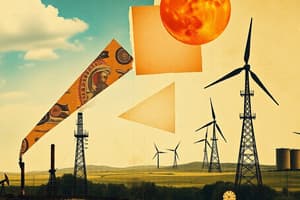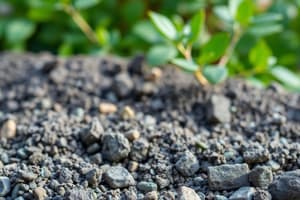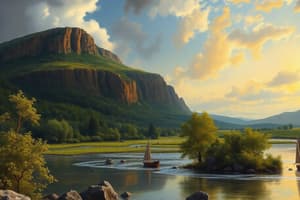Podcast
Questions and Answers
What is the primary consequence of erosion caused by poor soil management?
What is the primary consequence of erosion caused by poor soil management?
- Increased soil nutrients
- Improved soil structure
- Enhanced plant growth
- Detachment and movement of soil particles (correct)
Which of the following is a result of soil acidification?
Which of the following is a result of soil acidification?
- Increased plant diversity
- Concentration of acidic cations (correct)
- Higher pH levels
- Boosted soil fertility
What does salinization primarily affect?
What does salinization primarily affect?
- Soil physical quality (correct)
- Soil moisture levels
- Soil organic matter
- Soil's nutrient content
What term describes the degradation of productive land in arid and semi-arid areas?
What term describes the degradation of productive land in arid and semi-arid areas?
How does heavy metal contamination affect soil microorganisms?
How does heavy metal contamination affect soil microorganisms?
What is eutrophication primarily caused by?
What is eutrophication primarily caused by?
Which of the following human activities can lead to poor soil management?
Which of the following human activities can lead to poor soil management?
What is a significant factor contributing to soil pollution?
What is a significant factor contributing to soil pollution?
What is the primary process involved in decompression melting?
What is the primary process involved in decompression melting?
Where do decompression melting processes commonly occur?
Where do decompression melting processes commonly occur?
How does pressure affect the melting point of mantle rock?
How does pressure affect the melting point of mantle rock?
What is a mantle plume?
What is a mantle plume?
What process occurs when hot liquid rock intrudes into colder crust?
What process occurs when hot liquid rock intrudes into colder crust?
Which component is NOT typically found in magma?
Which component is NOT typically found in magma?
What triggers the buoyant magma to rise during decompression melting?
What triggers the buoyant magma to rise during decompression melting?
What is the relationship between tectonic activity and magma formation?
What is the relationship between tectonic activity and magma formation?
What defines waste?
What defines waste?
Which type of waste is primarily generated from households?
Which type of waste is primarily generated from households?
Which of the following is a major component of municipal solid waste?
Which of the following is a major component of municipal solid waste?
What kind of waste is generated by manufacturing processes?
What kind of waste is generated by manufacturing processes?
How do developed countries' waste generation compare to that of developing countries?
How do developed countries' waste generation compare to that of developing countries?
What is the main purpose of classifying wastes?
What is the main purpose of classifying wastes?
Which of the following is NOT a common component of industrial solid waste?
Which of the following is NOT a common component of industrial solid waste?
What is pollution primarily defined as?
What is pollution primarily defined as?
What happens to the older rock during sea-floor spreading?
What happens to the older rock during sea-floor spreading?
Which type of plate boundary involves plates moving towards each other?
Which type of plate boundary involves plates moving towards each other?
What is the average rate of tectonic plate movement?
What is the average rate of tectonic plate movement?
Which of these is NOT a type of convergent boundary?
Which of these is NOT a type of convergent boundary?
What is the movement of plates in a divergent boundary primarily characterized by?
What is the movement of plates in a divergent boundary primarily characterized by?
Which of the following describes a lateral plate boundary?
Which of the following describes a lateral plate boundary?
How does the rate of plate movement vary in the North Atlantic compared to the Pacific?
How does the rate of plate movement vary in the North Atlantic compared to the Pacific?
Which type of convergent boundary would likely lead to the formation of mountains?
Which type of convergent boundary would likely lead to the formation of mountains?
What is the primary characteristic of non-renewable energy sources?
What is the primary characteristic of non-renewable energy sources?
Which of the following processes is involved in refining petroleum?
Which of the following processes is involved in refining petroleum?
What fossil fuel is primarily composed of hydrocarbons and used for making diesel, asphalt, and kerosene?
What fossil fuel is primarily composed of hydrocarbons and used for making diesel, asphalt, and kerosene?
Which fossil fuel is a solid material formed mainly from carbon and is used as a fuel?
Which fossil fuel is a solid material formed mainly from carbon and is used as a fuel?
How is natural gas primarily composed?
How is natural gas primarily composed?
Which renewable energy source specifically utilizes the flow of water for electricity generation?
Which renewable energy source specifically utilizes the flow of water for electricity generation?
What type of energy is created from the splitting of atoms?
What type of energy is created from the splitting of atoms?
What process describes how coal was formed from ancient plants?
What process describes how coal was formed from ancient plants?
Which energy conversion step comes directly after heat energy is generated in fossil fuels?
Which energy conversion step comes directly after heat energy is generated in fossil fuels?
Which renewable energy source specifically generates electricity using recently dead organisms?
Which renewable energy source specifically generates electricity using recently dead organisms?
Which of the following is NOT a type of fossil fuel?
Which of the following is NOT a type of fossil fuel?
What is the main environmental concern related to fossil fuels?
What is the main environmental concern related to fossil fuels?
What type of process is geomorphic processes described as?
What type of process is geomorphic processes described as?
Which fossil fuel is formed from tiny marine organisms that died and were buried on the ocean floor?
Which fossil fuel is formed from tiny marine organisms that died and were buried on the ocean floor?
What is the expected increase in waste production over the next 30 years?
What is the expected increase in waste production over the next 30 years?
Which of the following is NOT a problem caused by improper waste management?
Which of the following is NOT a problem caused by improper waste management?
How many single-use sachets are used daily in the Philippines?
How many single-use sachets are used daily in the Philippines?
What is considered microplastic?
What is considered microplastic?
Which of the following is a consequence of microplastic pollution?
Which of the following is a consequence of microplastic pollution?
What solution is suggested to address waste management issues?
What solution is suggested to address waste management issues?
What is a significant health impact of waste incineration?
What is a significant health impact of waste incineration?
How many marine creatures die annually due to microplastic pollution?
How many marine creatures die annually due to microplastic pollution?
Flashcards
Non-renewable energy
Non-renewable energy
Energy from sources that will run out or will be replenished very slowly in our lifetime.
Fossil fuels
Fossil fuels
Energy sources formed from ancient, buried plant and animal remains.
Crude oil
Crude oil
A fossil fuel consisting of hydrocarbon chains, used in various fuels.
Coal
Coal
Signup and view all the flashcards
Natural gas
Natural gas
Signup and view all the flashcards
Petroleum
Petroleum
Signup and view all the flashcards
Fractional distillation
Fractional distillation
Signup and view all the flashcards
Renewable energy
Renewable energy
Signup and view all the flashcards
Solar energy
Solar energy
Signup and view all the flashcards
Biofuel
Biofuel
Signup and view all the flashcards
Hydroelectric energy
Hydroelectric energy
Signup and view all the flashcards
Geothermal energy
Geothermal energy
Signup and view all the flashcards
Wind energy
Wind energy
Signup and view all the flashcards
Heat energy
Heat energy
Signup and view all the flashcards
Kinetic energy
Kinetic energy
Signup and view all the flashcards
Magma
Magma
Signup and view all the flashcards
Magma Formation
Magma Formation
Signup and view all the flashcards
Decompression Melting
Decompression Melting
Signup and view all the flashcards
Divergent Boundaries
Divergent Boundaries
Signup and view all the flashcards
Mantle Plumes
Mantle Plumes
Signup and view all the flashcards
Convection
Convection
Signup and view all the flashcards
Transfer of Heat
Transfer of Heat
Signup and view all the flashcards
Igneous Intrusions
Igneous Intrusions
Signup and view all the flashcards
Waste Definition
Waste Definition
Signup and view all the flashcards
Waste Generation
Waste Generation
Signup and view all the flashcards
Waste Difference
Waste Difference
Signup and view all the flashcards
Pollution Definition
Pollution Definition
Signup and view all the flashcards
Soil Pollution
Soil Pollution
Signup and view all the flashcards
Municipal Solid Waste (MSW)
Municipal Solid Waste (MSW)
Signup and view all the flashcards
Soil Erosion
Soil Erosion
Signup and view all the flashcards
Desertification
Desertification
Signup and view all the flashcards
MSW Components
MSW Components
Signup and view all the flashcards
Industrial Solid Waste
Industrial Solid Waste
Signup and view all the flashcards
Soil Acidification
Soil Acidification
Signup and view all the flashcards
Industrial Waste Components
Industrial Waste Components
Signup and view all the flashcards
Salinization
Salinization
Signup and view all the flashcards
Heavy Metal Contamination
Heavy Metal Contamination
Signup and view all the flashcards
Eutrophication
Eutrophication
Signup and view all the flashcards
Poor Soil Management
Poor Soil Management
Signup and view all the flashcards
Global Waste Production
Global Waste Production
Signup and view all the flashcards
Sachet Economy
Sachet Economy
Signup and view all the flashcards
Landslide Risk
Landslide Risk
Signup and view all the flashcards
Water Contamination
Water Contamination
Signup and view all the flashcards
Microplastic
Microplastic
Signup and view all the flashcards
Microplastic Impact
Microplastic Impact
Signup and view all the flashcards
Waste Management Solutions
Waste Management Solutions
Signup and view all the flashcards
Accessible Waste Management
Accessible Waste Management
Signup and view all the flashcards
Sea-floor spreading
Sea-floor spreading
Signup and view all the flashcards
Oceanic Ridge
Oceanic Ridge
Signup and view all the flashcards
Ocean-Continent Convergence
Ocean-Continent Convergence
Signup and view all the flashcards
Ocean-Ocean Convergence
Ocean-Ocean Convergence
Signup and view all the flashcards
Continent-Continent Convergence
Continent-Continent Convergence
Signup and view all the flashcards
Transform Boundary
Transform Boundary
Signup and view all the flashcards
Study Notes
Energy Resources
- Energy is the ability to do work and exists in many forms
- Non-renewable energy sources are those that will run out in our lifetime
- Fossil fuels are formed from fossilized remains of plants and animals, high in carbon content
Fossil Fuels
- Oil (Petroleum): Mined, then transported to refineries to create usable fuels (gasoline, propane, kerosene)
- Crude oil is a fossil fuel made up of hydrocarbon chains mainly used to make diesel, asphalt, and kerosene
- Natural Gas: Composed mostly of methane, used as fuel for making materials and chemicals
Fossil Fuels Formation
- Tiny marine plants and animals died and were buried on the ocean floor.
- Over millions of years, the remains were buried deeper and deeper.
- The enormous heat and pressure turned the remains into oil and natural gas.
- Today, we drill down through layers of sand, silt and rock to reach the rock formations that contain oil and natural gas.
- Peat, via pressure from rocks, is transformed into coal.
- Coal is formed from dead plants over millions of years.
Nuclear Energy
- A non-renewable energy. This generates electricity from splitting atoms
Renewable/Alternative Energy
- Energy sources not based on burning fossil fuels or splitting atoms
- Solar energy: Uses the energy from the sun.
- Biofuels: Uses the recently dead organisms to generate electricity
- Hydroelectric energy: Uses water flow to generate electricity.
- Geothermal energy: Uses the Earth's crust heat to generate electricity
- Wind energy: Using wind turbines to generate electricity.
- Heat energy: The energy from bond breaking/formation.
- Kinetic energy: Heat energy used to convert water to steam.
- Mechanical energy: Generated from kinetic energy, used to turn turbines and other mechanisms
- Electrical energy: Mechanical energy converted to electricity via electromagnetism
Environmental Concerns: Fossil Fuels
- Fossil fuels cause air and water pollution; CO2 (43% of global emissions) produced are at a level harmful to the environment (oil and coal).
- Renewable sources are slowly replacing fossil fuels
Geomorphic Processes
- Physical processes that create and modify landforms on the surface of the Earth
- Endogenous (internal): Processes beneath Earth's surface
- Exogenous (external): Processes on Earth's surface
Weathering
- Disintegration and decomposition of rocks in situ (in their original locations). This doesn't involve transportation.
- Produces regolith
Degradation
- Processes that break down landforms – weathering, mass wasting, erosion, and transportation
- Includes denudation processes
Mass Wasting
- Downslope movement of rock, soil, and other debris due to the pull of gravity
- Factors affecting or inducing mass wasting events include: speed, type of material, water content, nature of movement, soil cover, and geologic features.
Soil Resources
- Soil: A mixture of mineral grains, organic matter, water, and air. It supports plant growth.
- Soil components include: mineral grains; water; nutrients; and organic matter (humus)
- Soil texture: The proportion of particles (clay, silt, and sand) that determines soil properties.
- Soil profile: The sequence of soil horizons from the surface to the bedrock
Waste Management
- Waste generation from human actives
- Waste classifications (MSW and industrial solid waste)
- Waste management – reduce waste, dumping in landfills, recycling, incineration, composting, sewage treatment, etc.
- Improper waste management causes environmental problems
Plate Tectonics
- Earth's crust is divided into plates that move.
- Plate movement causes collisions, separation, or sliding.
- Plate movement involves decompression melting, which creates magma.
Magma
- Molten or semi-molten rock mixture under the Earth's surface.
- It involves a multitude of processes like magma formation and transfer of heat.
- Magma is formed by several processes including decompression melting and flux melting
Metamorphism
- Alteration of the composition or structure of a rock by extreme heat and pressure
- Different types of metamorphism: contact, cataclastic, hydrothermal, regional, burial, and shock/impact.
Oceanic Drills, Samples and Types of Plate Movements
- Younger rocks found near mid-ocean ridges; older rocks found farther away from ridges.
- Types of plate boundaries: convergent, divergent, and lateral (strike-slip)
Natural Water Resources
- Water makes up 71% of Earth's surface
- Groundwater is the underground water in pore spaces (regolith and bedrock).
- Surface water is water on the Earth's surface (oceans, rivers, lakes, etc.).
Studying That Suits You
Use AI to generate personalized quizzes and flashcards to suit your learning preferences.




